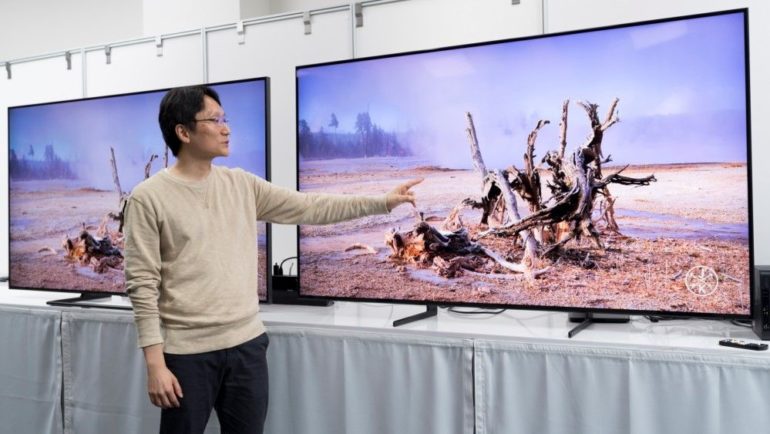What is 8K resolution? More of the top TV brands are looking to the futuristic ultra-high definition technology to add to the latest crop of premium television sets. That means it’s likely you’re hearing the word ‘8K’ thrown around more and more these days, especially after CES 2021.
However, when it comes to understanding what exactly 8K means for video quality, home cinema, and you, the answer isn’t always straightforward.
2019 was when 8K really kicked off, with the LG 8K OLED and LG SM99 taking up shelf-space alongside the Samsung Q950R QLED – which got a nifty 55-inch size later in the year – Sony Z9G, and TCL’s new X-Series TV.
There are enough 8K TVs now that we needed a best 8K TV guide just to sift through them. What’s more, there are only more on the way – with multiple announcements at CES 2021 of new 8K models, promising advances in processing and ramped-up manufacturing in order to offer sharper and more affordable (but still pretty expensive) sets.
Over the coming years, you can expect to hear more from the 8K Association – a community of TV makers that include Samsung Electronics, Panasonic, Hisense, TCL, and AU Optronics.
This association was set up to guide the visual standard of the future, and has introduced a new 8K standard to ensure consumers know they’re getting minimum specs suited to the high-resolution panel (even if LG goes by slightly different measurements).
Other TV-tangential companies, such as Tencent, Xperi, Intel, and Chili have also joined the 8K Association, showing an expanded desire by technological organizations to invest in (and shape) the development of the advanced panel resolution.
As manufacturers, broadcasters, and production studios are starting to get behind the new technology, it’s crucial to know what you can expect to see on your televisions in the coming years, and the 8K technology that’s actually on offer now.
You can see all the latest info on 8K in this guide below, along with what exactly 8K is, how it works, and the difference it makes from 4K.
What is 8K resolution?
8K is nothing short of the clearest picture you’re ever likely to see. It’s got four times more pixels than 4K images, measuring 7680×4320 pixels, which equates to a total of 33,177,600 pixels.
In a 65-inch screen they are so small you won’t even be able to make out the pixel structure – though many 8K TVs are much, much larger.
Why is it called 8K?
It’s called 8K because the images are roughly 8,000 pixels wide, give or take a few hundred, but the specification also comes under the umbrella term Ultra HD, so some people use the term Ultra HD 8K. Others still call it 8K Super Hi-Vision, such as NHK – Japan’s largest public broadcaster – which invented it back in the year 2000 and branded it in 2012.
Absolutely, yes. Full HD 1080p TVs gave you a two-megapixel image, which isn’t much compared even to what your smartphone’s camera is capable of. 4K ups that to eight megapixels, which still seems underwhelming considering the capabilities of human vision and, again, what smartphone screens can now achieve.
So the 33-megapixel image of 8K – the next mathematical step-up from 4K – could at last provide the kind of immersion we’ve been searching for. Or, at least, that’s the theory.
Are 8K TVs already on sale?
Yes, and you’ve been able to do so for a little while now already.
We’ve come a long way from the proof of concept 8K TVs we’ve been seeing at conferences for the past few years. When we first saw the 98ZHQ2R TV from Chang Hong back in 2017, the 98-inch set appeared to be held in place by something akin to scaffolding, so thick were the supports.
But that’s all changed now – the latest wave of 8K TVs are every bit as thin and home-friendly as what we now expect from our existing 4K TV models.
Are there different kinds of 8K?
LG has released a range of 8K TVs a year after they were first announced (we’ll cover those later), but the interesting thing is LG claims competitors don’t offer the same experience as LG’s real 8K.
So what’s this argument about “real 8K”? Well, LG is citing the Information Display Measurements Standard (IDMS) for pixel differentiation, arguing that 8K TVs shouldn’t just be defined by the number of pixels they have (7,680 x 4,320), but also how well the TV panel can distinguish / contrast between those pixels. If those tiny self-emissive dots start to merge the brightness or colors of their output, then there’s little point in having so many.
LG claims its new 8K TVs achieve this Contrast Modulation (CM) “in the 90 percent range”, leading to what it calls “real 8K”. (The IDMS standard only requires 25 percent for images, or 50 percent for text.)
These claims came only a day after the 8K Association, an organization for encouraging the adoption and development of 8K, with members including Samsung, Panasonic, Hisense, and TCL – though notably not LG – set out its own standard for 8K TVs. Its mainly sensible stuff, such as HDMI 2.1 ports, high enough frame rates, 8K resolution, and a minimum 600 nits peak brightness, but no mention of the Contrast Modulation measurement used by LG.
So what mainstream 8K TVs are on the market?
At CES 2021, a number of new 8K TVs were unveiled, but we’re particularly interested in announcements from Samsung and LG.
We had an early hands-on with two of Samsung’s 8K offerings, including the newly-announced Samsung Neo QN900 8K QLED TV, the brand’s top-of-the-line TV for 2021, as well as the Samsung Neo QN800 8K QLED TV, which we’ve dubbed the first 8K television for many early adopters.
From LG, CES 2021 saw the release of two new 8K TVs, the LG Nano9Z QNED 8K TV, which is this year’s highest-spec ‘QNED’ television, as well as the LG Nano9X QNED 8K TV, which cleaves close to the Nano9Z, as a QNED / MiniLED 8K TV, but makes do with a 60Hz panel rather than 120Hz. For more on these new TVs from LG, visit our LG TV 2021 guide.
Best 8K TV: what’re the very best 8K sets you can buy?
But it’s not just new 8K TVs that are worth mentioning here. We’ve been blown away by the quality of some 8K TVs since 2018. For example, the Samsung Q900R 8K TV was released in late 2018, and garnered a whopping five stars from the TechRadar team – albeit with a similarly whopping price tag.
In the UK you were paying £4,999 for the 65-inch model or £6,999 for the 75-inch – while the 85-inch model is retailing for £14,999 / $14,999. A new 55-inch model was announced in late 2019 as well.
The 88-inch LG 8K OLED and 75-inch LG Nano Cell 8K LED TV have rolled out in the US, UK, Australia, France, and Germany too – making use of LG’s a9 Gen 2 processor, with four HDMI 2.1 ports (unlike the port-poor Sony Z9G). So even OLED TVs are getting in on the action.
It’s also worth checking out TCL’s range, including the TCL Mini LED TV with 8K and AI learning, as well as this TCL’s new X-Series TV that has an 8K resolution, uses AI learning, has a retractable camera and supports augmented reality content. Yep, you read that right. It also has a ‘duo-display design’ that ‘allows viewers to enjoy a mini-screen independently’.
Does an 8K TV need HDMI 2.1?
Yes – and they all will have the new specification of the HDMI cable, which for the first time allows 8K resolutions to pass through. HDMI 2.1 is a major enabler of the forthcoming 8K resolution revolution, making sure TVs accept 8K resolutions at 60 frames per second (or 4K resolution at 120 frames per second).
Where will 8K content come from?
There are many sources that will produce 8K content. The first is Hollywood, whose directors have begun to use the new RED Weapon 8K camera (Guardians of the Galaxy Vol. 2 has already been filmed this way in 8K).
And with the advent of truly commercial 8K TVs, there’s sure to be a growing market of 8K content from all sorts of traditional TV production studios (and likely Netflix).
Second is the Tokyo Olympics, which means waiting until 2020. However, 8K will only be broadcast by NHK in Japan itself.
Coinciding with the IFA 2019 technology expo, Samsung has partnered with a number of streaming services across Europe – including CHILI, MEGAGOGO, and The Explorers – to start displaying 8K HDR10+ content.
Lastly – and perhaps most tellingly – 8K content will come from all of us. 8K capture from 360-degree video cameras is already offered by the GoPro Omni VR and Insta360 Pro, which was launched at CES 2017.
“Talk to the VR guys and they’re tell you that the higher the resolution and frames rates, the better,” says Jeff Park, Director of Marketing at HDMI Licensing, whose new HDMI 2.1 permits 8K image transfer. “VR today looks good but it lacks fidelity … if it was affordable and practical, they would do 8K now,” he says. 8K-per-eye VR headsets, anybody? They’re surely in the pipeline alongside a wider field of view.
But, in the interim, it’ll be advanced upscaling processors that will take full HD and 4K content and make them ready for the 8K big time, redefining the sharpness possible from existing sources.
8K TVs aren’t likely to feel like necessary purchases for a while yet, but there’s already enough content on the horizon for us to expect a bright future for the high-def technology.



